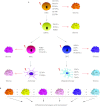On the origin of glioma
- PMID: 22348397
- PMCID: PMC3339543
- DOI: 10.3109/03009734.2012.658976
On the origin of glioma
Abstract
Glioma is the most frequent primary brain tumor of adults that has a presumably glial origin. Although our knowledge regarding molecular mechanisms and signaling pathways involved in gliomagenesis has increased immensely during the past decade, high-grade glioma remains a lethal disease with dismal prognosis. The failure of current therapies has to a large extent been ascribed the functional heterogeneity of glioma cells. One reason for this heterogeneity is most certainly the large number of variations in genetic alterations that can be found in high-grade gliomas. Another factor that may influence glioma heterogeneity could be the cell type from which the glioma is initiated. The cell of origin for glioma is still undefined, and additional knowledge about this issue may prove critical for a more complete understanding of glioma biology. Based on information from patients, developmental biology, and experimental glioma models, the most putative target cells include astrocytes, neural stem cells, and oligodendrocyte precursor cells, which are all discussed in more detail in this article. Animal modeling of glioma suggests that these three cell types have the capability to be the origin of glioma, and we have reason to believe that, depending on the initiating cell type, prognosis and response to therapy may be significantly different. Thus, it is essential to explore further the role of cellular origin in glioma.
Figures

Similar articles
-
The cellular origin for malignant glioma and prospects for clinical advancements.Expert Rev Mol Diagn. 2012 May;12(4):383-94. doi: 10.1586/erm.12.30. Expert Rev Mol Diagn. 2012. PMID: 22616703 Free PMC article. Review.
-
Developmental origins and oncogenic pathways in malignant brain tumors.Wiley Interdiscip Rev Dev Biol. 2019 Jul;8(4):e342. doi: 10.1002/wdev.342. Epub 2019 Apr 3. Wiley Interdiscip Rev Dev Biol. 2019. PMID: 30945456 Free PMC article. Review.
-
The cell of origin dictates the temporal course of neurofibromatosis-1 (Nf1) low-grade glioma formation.Oncotarget. 2017 Jul 18;8(29):47206-47215. doi: 10.18632/oncotarget.17589. Oncotarget. 2017. PMID: 28525381 Free PMC article.
-
Cell of origin determines tumor phenotype in an oncogenic Ras/p53 knockout transgenic model of high-grade glioma.J Neuropathol Exp Neurol. 2012 Aug;71(8):729-40. doi: 10.1097/NEN.0b013e3182625c02. J Neuropathol Exp Neurol. 2012. PMID: 22805776 Free PMC article.
-
Mosaic analysis with double markers reveals tumor cell of origin in glioma.Cell. 2011 Jul 22;146(2):209-21. doi: 10.1016/j.cell.2011.06.014. Epub 2011 Jul 7. Cell. 2011. PMID: 21737130 Free PMC article.
Cited by
-
MMP2 is associated with glioma malignancy and patient outcome.Int J Clin Exp Pathol. 2018 Jun 1;11(6):3010-3018. eCollection 2018. Int J Clin Exp Pathol. 2018. PMID: 31938426 Free PMC article.
-
Lesion covariance networks reveal proposed origins and pathways of diffuse gliomas.Brain Commun. 2021 Dec 4;3(4):fcab289. doi: 10.1093/braincomms/fcab289. eCollection 2021. Brain Commun. 2021. PMID: 34917940 Free PMC article.
-
Emerging Role of Glioma Stem Cells in Mechanisms of Therapy Resistance.Cancers (Basel). 2023 Jul 1;15(13):3458. doi: 10.3390/cancers15133458. Cancers (Basel). 2023. PMID: 37444568 Free PMC article. Review.
-
Adenosine Targeting as a New Strategy to Decrease Glioblastoma Aggressiveness.Cancers (Basel). 2022 Aug 20;14(16):4032. doi: 10.3390/cancers14164032. Cancers (Basel). 2022. PMID: 36011024 Free PMC article. Review.
-
Adult mouse subventricular zones stimulate glioblastoma stem cells specific invasion through CXCL12/CXCR4 signaling.Neuro Oncol. 2015 Jan;17(1):81-94. doi: 10.1093/neuonc/nou144. Epub 2014 Aug 1. Neuro Oncol. 2015. PMID: 25085362 Free PMC article.
References
-
- Phillips HS, Kharbanda S, Chen R, Forrest WF, Soriano RH, Wu TD, et al. Molecular subclasses of high-grade glioma predict prognosis, delineate a pattern of disease progression, and resemble stages in neurogenesis. Cancer Cell. 2006;9:157–73. - PubMed
Publication types
MeSH terms
LinkOut - more resources
Full Text Sources
Medical
Miscellaneous
